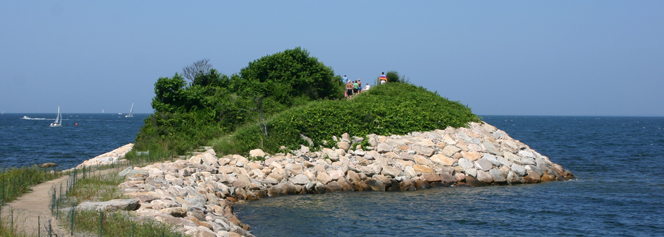

The Knob Revetment Reconstruction
 The Knob and the long low landform that leads to it has had artificial rock armor or “riprap” protecting it since at least as early as 1912 when the newspaper carried an article announcing that Jack Martin completed the work for Stephen W. Carey, Jr. The remnants of some of that work can be seen in the sand of the Buzzard’s Bay beach some 15 to 20 feet out from the present armor line. In 1973, Cornelia Carey, one of Stephen’s daughters and the then owner of the property, completed a repair performed by the Lawrence Lynch Company, raising the armor to the top of the Knob promontory and adding chinking stone there and elsewhere along the narrow causeway known as a “revetment” in the terminology of coastal engineering.
The Knob and the long low landform that leads to it has had artificial rock armor or “riprap” protecting it since at least as early as 1912 when the newspaper carried an article announcing that Jack Martin completed the work for Stephen W. Carey, Jr. The remnants of some of that work can be seen in the sand of the Buzzard’s Bay beach some 15 to 20 feet out from the present armor line. In 1973, Cornelia Carey, one of Stephen’s daughters and the then owner of the property, completed a repair performed by the Lawrence Lynch Company, raising the armor to the top of the Knob promontory and adding chinking stone there and elsewhere along the narrow causeway known as a “revetment” in the terminology of coastal engineering.
After a few more minor repairs subsequently, in the late 1980s and early 1990s period, it became evident that storm damage and the effects of ever increasing public use required attention to some scope of basic repair to the armoring and special features like the top of the Knob promontory, as well as sinkholes and drainage issues along the long, narrow causeway or revetment. “Soft solutions” like planting were simply not up to the high energy weather impacts and heavy, and sometimes careless, human traffic and vandalism. The interested parties listened to consultant presentations ranging from recommendations to remove all armor and allow accelerated erosion to gradually destroy the Knob features as they now exist, to one hundred year storm designs consisting of all heavy stonework without room for soil or vegetation. A decision was made to attempt to design and fund an intermediate reconstruction as permitted by the regulators to create a baseline condition which would permit periodic and more minor repairs as needed in the future. This decision was based on a belief that preserving the Knob as a destination, protection for the outer harbor, and preservation of an aesthetic, natural and recreational resource are worthwhile objectives. The work was viewed as part of a larger plan for management and maintenance of the Knob property, as well as related necessary fundraising.
 Permitting efforts began in 2001 and 2002, following numerous earlier studies and contractor estimates. These efforts extended into 2002 and 2003 before the Falmouth Conservation Commission and state environmental agencies, through to federal agency review coordinated by the Army Corps of Engineers. Final permitting was achieved in 2004. Review for and selection of a contractor was concluded in the fall of 2004 with a contract between AGM Marine Contractors, Inc. of Mashpee and the Quissett Harbor Preservation Trust, Inc. The work was scheduled for the permitted construction activity “window” of November 1, 2004 through April 1, 2005, dictated to avoid negative impacts on fisheries resources. This work window pushed the work into the harsh and snowy conditions of that winter. A temporary construction access road was constructed off the existing fire road, down the middle of the coastal bank and dune. The access road was built with 6”-12” pieces of trap rock or bedding stone laid on filter cloth and extended down the Buzzards Bay beach out to the midpoint of the causeway on the north side. It was further extended over the causeway and then extended along side it to each extremity of the existing armor.
Permitting efforts began in 2001 and 2002, following numerous earlier studies and contractor estimates. These efforts extended into 2002 and 2003 before the Falmouth Conservation Commission and state environmental agencies, through to federal agency review coordinated by the Army Corps of Engineers. Final permitting was achieved in 2004. Review for and selection of a contractor was concluded in the fall of 2004 with a contract between AGM Marine Contractors, Inc. of Mashpee and the Quissett Harbor Preservation Trust, Inc. The work was scheduled for the permitted construction activity “window” of November 1, 2004 through April 1, 2005, dictated to avoid negative impacts on fisheries resources. This work window pushed the work into the harsh and snowy conditions of that winter. A temporary construction access road was constructed off the existing fire road, down the middle of the coastal bank and dune. The access road was built with 6”-12” pieces of trap rock or bedding stone laid on filter cloth and extended down the Buzzards Bay beach out to the midpoint of the causeway on the north side. It was further extended over the causeway and then extended along side it to each extremity of the existing armor.
The reconstruction work began at the outer end of the Knob on the west, with a large tracked excavator sitting precariously at the base, able to reach to the top. Existing armor was pulled down, bedding stone laid over filter cloth, and then heavy armor stone re-placed and fitted over the bedding stone. As each section was finished, specially purchased natural color chinking stone was added into and over the spaces between the larger armor elements. This process was repeated in sections as excavators worked in on the south from the outer Knob and from the inner harbor end toward the middle. An estimated 2100 tons of small bedding or backer stone was used in the work, together with 1200 tons of 6-ton toe stone for foundation, and 3000 tons of additional riprap. As the work progressed, the trap rock road was removed and used for the foundation for subsequent sections. The top of the Knob was terraced and stairs built up to it by William “Bill” Armstrong of Falmouth as a subcontractor to AGM for this work, as well as the stairs leading up from the sides at the beginning of the causeway, with a carpentry assist by John Vose of Falmouth. Reconstruction finished up on the north side in April 2005 by similar methods.
Spring storms in May 2005 evidenced the need for further work on the narrow revetment and the necessary repairs were completed by AGM and Bill Armstrong in the winter of 2005 and spring of 2006. Planting with native grasses and plants followed the completion. The challenge ahead on the outer Knob lies in the maintenance of the planting and chinking stone, necessitated by weather and damage from careless use and vandalism.
For a quick look at the engineering blueprints of the project, select a section drawing below.
Section A-A | Section B-B | Section C-C
Celebration Marks Two-Year Knob Restoration Project
by Andrew Cunningham
Falmouth Enterprise
Volume 116, Number 29
Tuesday, July 25, 2006
Falmouth residents and vistors for generations have wallked the trails leading to Quissett Knob - some in summer carrying picnic gear on their way to the beach, and others just enjoying the silence and beauty that the trails provide. The view from the Knob itself is breathtaking...Click here to download reprinted article in PDF file format.
